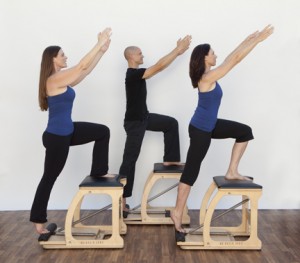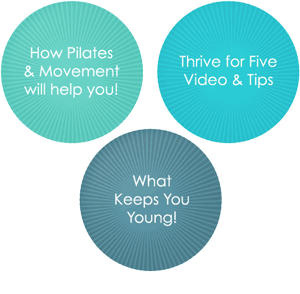Joseph Pilates’ ingenuity and genius can be seen in each piece of equipment he conceived. His original designs have endured down to this day with little or no modifications, testifying to their successful and brilliant conception and construction. The wunda chair is no exception.
Hoping to place a wunda chair in every living room, Joe originally designed the chair as the first piece of home gym equipment from the world of Pilates. Add a little padding and flip the chair 90 degrees, and you have a comfortable arm chair that can easily convert back to a useful and versatile piece of Pilates equipment. Though Joe’s plan to camouflage the wunda chair as an arm chair never caught on, it still fits snugly in the corner of a room without taking up much space while delivering perhaps the most opportunity per square inch for a wide array of challenging and exciting exercises. Let’s explore!
Stabilize!
Let’s begin with the chair’s relatively diminutive size, which logically must provide less support than its close cousins, the reformer and Cadillac. To test this statement, try to lie down comfortably on a reformer or Cadillac, and then try to lie down comfortably on a wunda chair. There is no position in which you can completely relax on the chair, which forces you to engage your body’s own support system. Exercises such as Mountain Climber, Step Up, Hamstring Stretch #3, and Tendon Stretch demonstrate well the challenge this piece of equipment brings to your balance, stability, and proprioception.
All Access
While challenging the client more with less, the chair’s diminutive size also allows the instructor a wonderful 360-degree view of the client during most exercises, affording the instructor more opportunity to correct and improve the client’s form and engagement.
The chair can be approached from any angle—in front, behind, above, below—and from many positions—sitting, lying, standing, prone, and supine. Combine all these angles and positions with transitions between each exercise and you can see the versatility that this piece of equipment offers—fighting off redundancy and boredom from your workouts.
Why Instructors Love the Wunda!
While its exercises run the gamut from beginner to advanced, I generally introduce the chair once a client has progressed and demonstrated good Pilates form and stability. Some of my favorite chair exercises include Hamstring Stretch #3, One-Arm Push-ups, and Frog. I also enjoy how Swan on the chair allows clients with a limited range of motion in the shoulder to perform and enjoy this extension exercise. Similarly, Mermaid on the chair can deliver the benefits and challenge of this stretch without exacerbating a tight hip with limited turnout.
A wonderfully challenging piece of equipment that offers Pilates lovers much opportunity for building strength and developing stability, the wunda chair certainly has earned its place in the Pilates studio.


Thanks for posting this! I’ve seen similar chairs like this in pilates studios, so I was wondering what they were used for. Usually, I would do pilates on a mat, so we’ve never really had the chance to work with any of the equipment that’s usually found on the other side of the room. It’s pretty cool that they can be used to help develop stability by using it for certain exercises. Perhaps it would be a good idea to request the instructor to let us use those chairs in class one of these days.
Hey the Wunda Chair looks like a great bit of kit for doing Pilates exercises, I’ll have to see if I can get myself one of those – Myleen Class